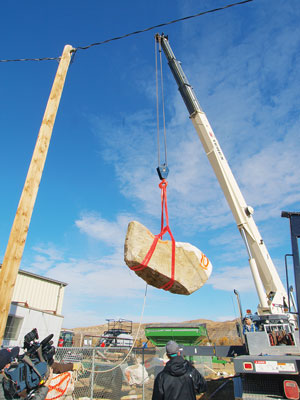The Royal Tyrrell Museum has had a busy fall, adding several huge specimens to their collections.
Normally, field work slows down once fall arrives, but crews have been out in force bringing back some exciting new finds.
On Friday, October 11, a crew headed by Dr. Francois Therrien arrived home with 11 massive blocks containing a duck-billed dinosaur from the Saddle Hills near Grande Prairie. The find, whether it’s a new species or not, is scientifically important for a number of reasons.

Crews unload the last of 11 massive blocks containing a duck-billed dinosaur from the Saddle Hills near Grande Prairie. The blocks weighed a total of 54,800 pounds, with the largest (pictured) estimated to be 14,000 pounds. It is hoped preparation will begin over the winter.
“Based on what was exposed, we know it is a duck-billed dinosaur. We don’t know what species it is, because all the details are in the head. We’ll need to do some preparation to determine if it’s something new,” said Therrien.
“Even if it’s something already described, it’s significant, because for that time period, the only dinosaurs we know of are in the southern-most Alberta. We have nothing that far north.”
The Tyrrell Museum was called in when a pipeline excavation crew exposed the specimen.
“We had the best case scenario. The cliff itself was mostly really soft rock and the bones were surrounded by really hard rock, so we used an excavator to get rid of all the soft stuff, leaving a huge concretion,” said Therrien.
Conditions were frigid, but the team persevered.
“The temperature was going below freezing most nights and during the day it would be about 12 Celsius. The coldest day we had was about 5 Celsius. It was often windy, so that wind chill factor came into play,” said technician Darren Tanke. “We were working pretty vigorously, so that kept us pretty warm.”
In the end, 11 blocks weighing a total of 54,800 pounds were loaded on to a trailer and hauled to Drumheller. The largest block weighed 14,000 pounds.
“We stopped at a rest area to tighten the straps and check everything, then a couple vehicles followed us in and just wanted to touch the fossils,” said John Schumacher, one of the drivers.
Bill Richot, the other driver, was excited to have helped transport the fossils.
“They’re a piece of history when you’re hauling something like this. It’s the tiniest bit, but still, you’re part of that history,” said Richot.
Two weeks ago, the Tyrrell also brought back a new find from the Korite Mine near Lethbridge. The site has already produced a number of spectacular specimens of marine reptiles and ammonites.
The new Korite specimen is thought to be a Mosasaurus, a large predatory marine reptile.
“It’s nearly complete, with some disarticulation, and the skull is there. It’s higher up (later in time) than some of the other specimens we’ve found there,” said Dr. Don Brinkman.
The specimen could be useful in investigating how Mosasaurs grow.
“This is the fourth specimen of Mosasaurus to come out of the mines. Each one has unique things about it. Together, they are significant, because they cover a wide range of sizes. They’ll be useful when looking at ontogenetic change (how an organism changes as it ages),” said Brinkman.
Tyrrell researchers were also in the Northwest Territories uncovering a unique specimen.
“We don’t yet know what it is. We’ll have to get the block prepared before we can figure it out,” said Brinkman.
All that is known at this point is the specimen is in from the late Devonian period (roughly 380 to 360 million years ago) and inhabited a shoreline environment.
Preparation of the specimens is expected to proceed over the winter.